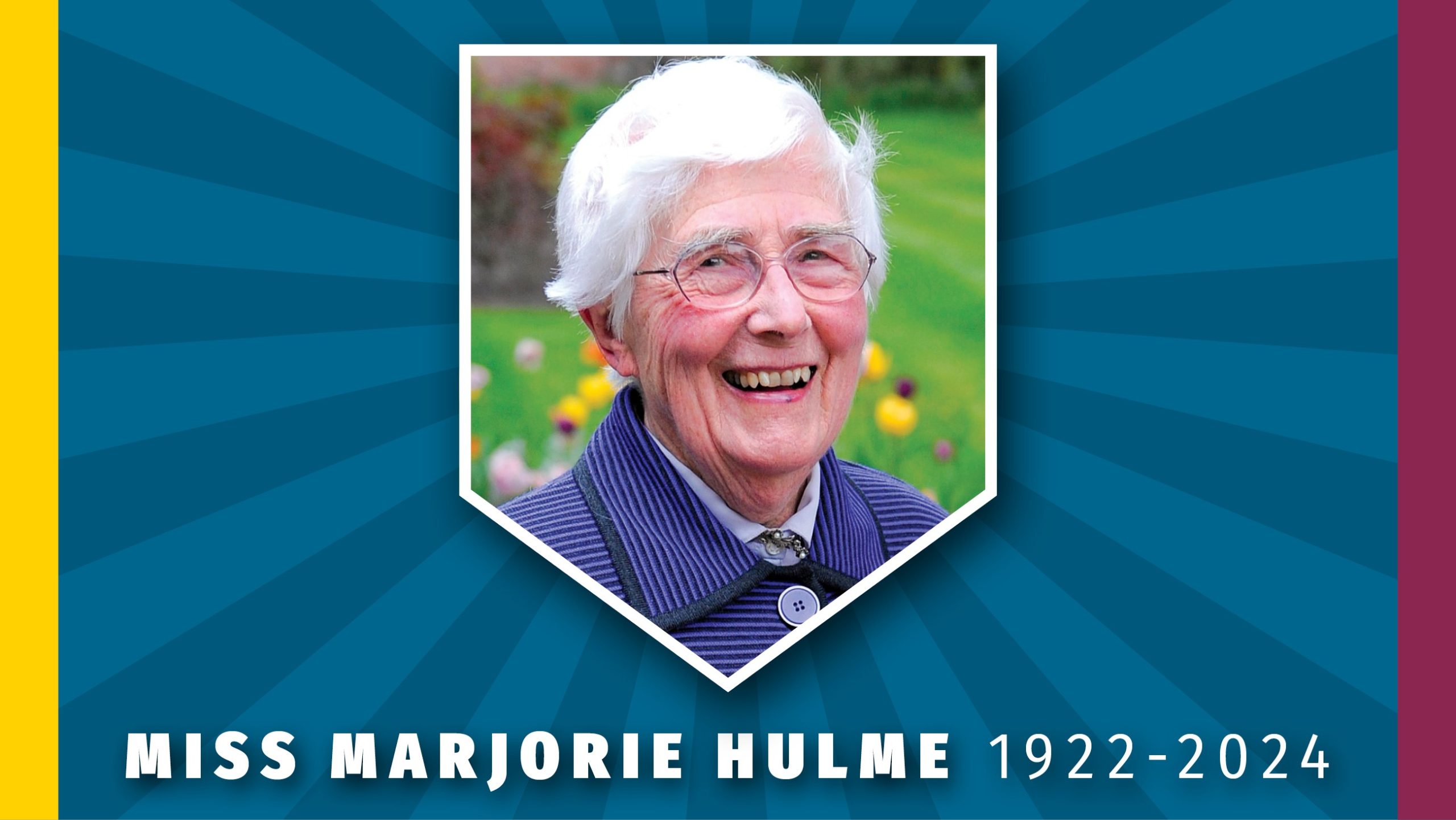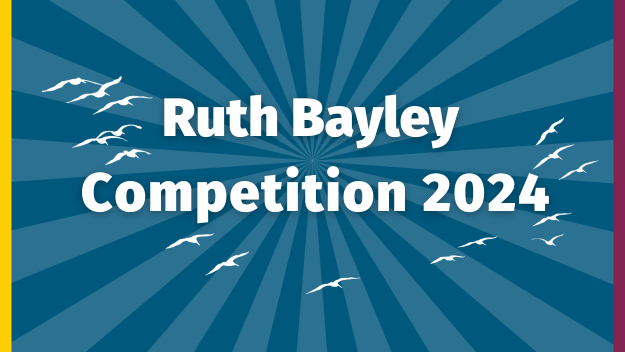2016
Six members of the Upper Sixth, along with Miss Browning and Miss O’Neal, took part in the thirteenth WGS trip to The Gambia. More can be read about the history and well-established connection with schools and villages in Gambia can be read on the WithGambia section of this website.
Saturday 10th December
Day One in The Gambia – Report from Sara B
Arriving at the airport in Banjul, we had no idea of how real our expectations of the West African coast would be. After a quick fan and water stop we were swiftly on our way to our Hotel Senegambia with a minibus tour guide.
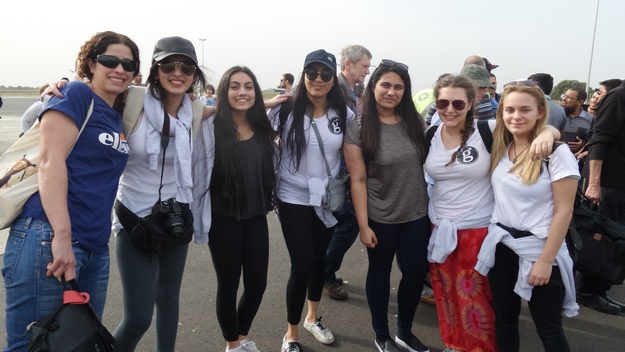
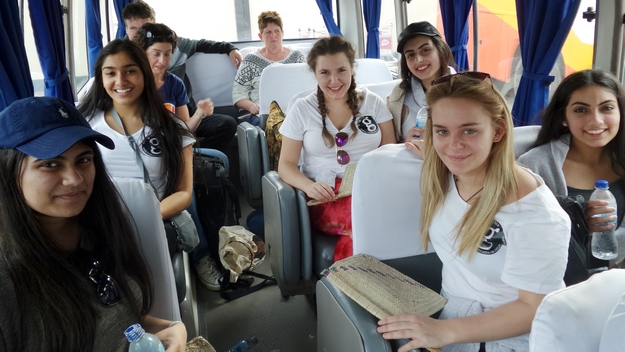
When we got to our hotel some rested and showered and others, more than ready for some coastal sunshine, headed for the many beach and swimming leisure facilities in the hotel grounds. In the evening we headed to a nearby restaurant with our guide Lamin and washed down a pleasant day with a lovely meal, some castanets and a distant call to prayer. The famous Gambian warmth was already clear to us from the hospitality and friendliness of the locals and staff.
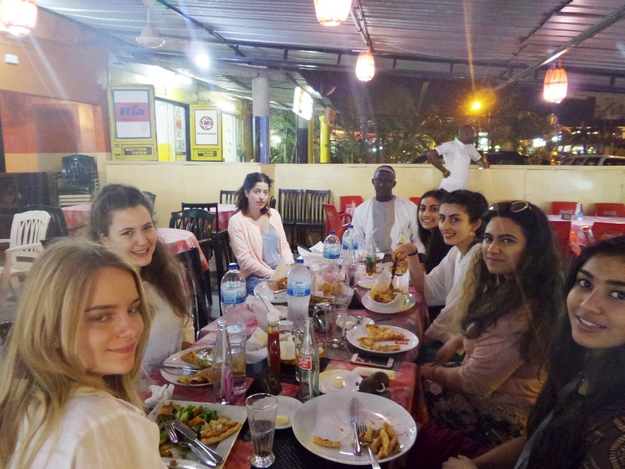
Sunday 11th December
Day 2 in The Gambia – Report from Amy JB
We are hoping to receive some photos soon
We began our first morning in the Gambia with a refreshing breakfast including local fruits, cake and baobab juice. From there we met our jeep driver for the week – Nikki ‘the Michael Jackson of The Gambia’ . Nikki provided great entertainment, even teaching us how to count to ten in Mandinka. We also met our guide’s brother, who is nickname is Smiler.
After a 20 minute jeep ride which provided a much welcome breeze in the 30 degree heat, we arrived in the capital of Banjul. The first thing that struck us upon arrival was the large stone archway. This was Arch 22 that symbolises the independence of Gambia from colonial rule. We climbed many flights of stairs until we reached the top gallery. Here we learnt about some of Gambia’s political, sporting and agricultural history. Smiler sang us the national anthem and explained everything to us very well and we all felt a deeper understanding of the country that we were all beginning to love.
Next we began to wander around the capital itself and it wasn’t long until our numbers doubled as we were accompanied by children from the local community. Whilst some poverty was evident in some areas walking around we felt a strong community spirit and everyone was very welcoming. Buildings were densely packed together and some were painted vibrant colours which added to the uplifting atmosphere. Despite this, some areas of the city were underdeveloped and felt unfinished but the people were cheerful and seemed excited to see us, we can clearly see why Gambia is called the smiling coast of Africa.
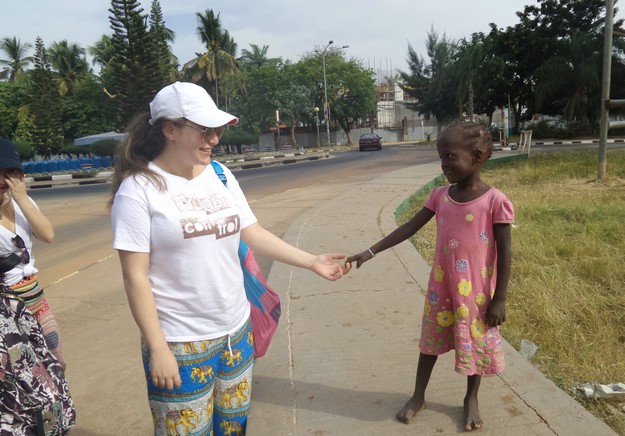
We weaved our way around the Albert Market in the centre of the city and, whilst it was a Sunday and quieter than usual, we could still appreciate the hustle and bustle. There were overwhelming smells of smoked fish and spices and bright clothing and fabrics hanging from various market stalls.
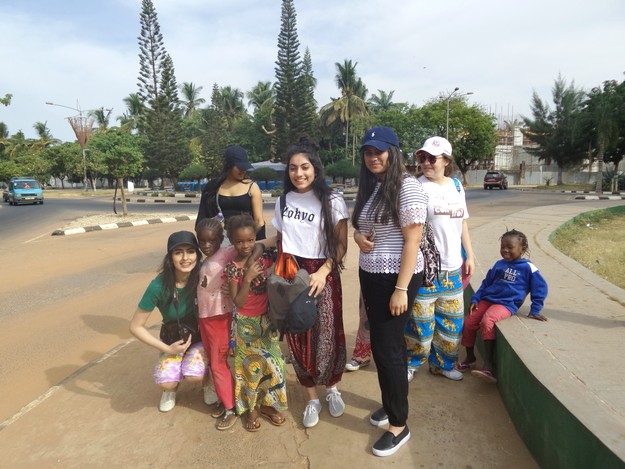
Then we were reunited with Nikki and headed back to the hotel to enjoy some sun then pack and prepare for the adventures ahead.
Monday 12th December
Day 3 – by Sophie B
This morning we woke up before sunrise. This was quite a task for all of us as we climbed into our jeep at 5 am with backpacks packed for the two days ahead, life jackets in hand. It took us about half an hour until we reached the port at Banjul. From here we waited and watched the beautiful Gambian sunrise and headed onto the ferry ready for our river crossing from the South to the North bank. The ferry ride was not too busy and the ride was smooth due to the fact it was a public holiday. Most of us dozed in an out and some enjoyed the fresh breeze and viewing wide expanses of calm river.
[easingsliderpro id=”53″]
The town we arrived at on the North Bank is called Barra. This town felt like authentic Gambia, the hustle and bustle created a real atmosphere contrary to the tourist orientated area of SeneGambia. Here we could buy anything from clothes to fabric to food from the rows and rows of market stalls and workshops. Here we had our breakfast of local bread, eggs and sweet bananas on the back of our jeep.
We then embarked on a two-hour journey along the flat plains. The smooth tarmac road was lined by expansive savanna grasslands which was broken up by majestic baobab trees and small communities. During our jeep ride we stopped about three times and at each stop the local children would runout to greet us and shake our hands. We gave them food and gifts which delighted the small children.
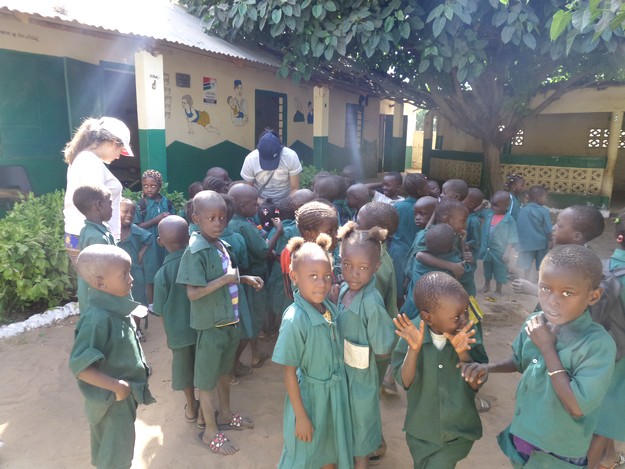
Our much awaited arrival at Mama Tamba nursery happened around 11 am. We were greeted with a crowd of the school children with their welcome song. Firstly the headmaster of the school Tamba proudly showed us round the school. He explained to us the improvements they had made due to our fundraising efforts with included retiled and re- roofed the toilet block and staffroom and installed electricity to every room in the school. After some refreshments we set to work whitewashing the first classroom, which was built by WGS in 2007. We then began to decorate the walls with vibrant and educational designs that we’d planned in advance. This including a number line of boats and an alphabet tree to aid the teachers in their lessons. After more refreshments we admired our handiwork and looked forward to seeing the children’s reactions the next day.
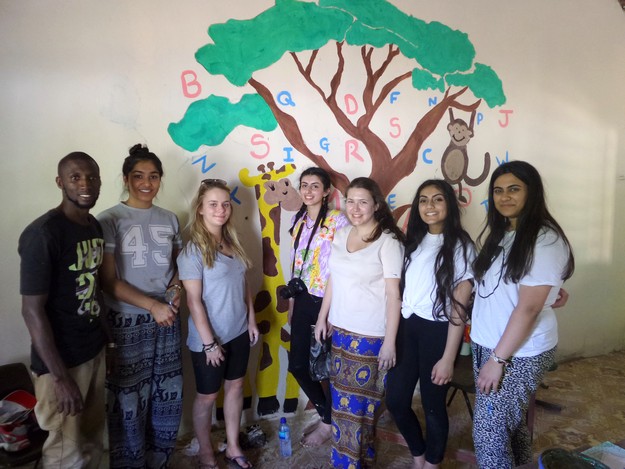
We then set off to Farafenni and settled in at a local guesthouse, where we enjoyed our evening meal with Lamin, Nikki and Smiler.
Tuesday 13th December
Day 4 – by Sophie B
Today we started the day with being woken up by a profusion of goats and roosters. After breakfast, we headed to the Songhi Agricultural Project, which is a World Bank funded initiative that teaches organic farming techniques. The extensive plantation uses renewable energy such as as biogas and solar panels to grow a variety of crops including papaya, sweetcorn and demon chillies. Tamba, the Headteacher uses these techniques to grow bananas, aloe Vera and papaya. These sustainable farming practices can then be taught to the children, through Tamba’s knowledge.
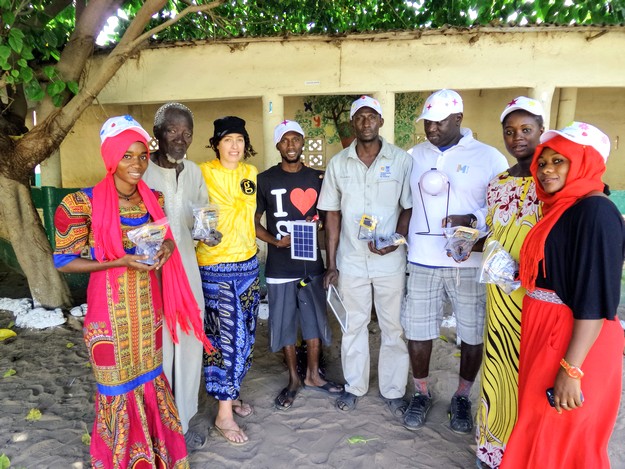
Once we arrived at Mama Tamba we gifted eight solar lamps to the local community and to the teachers at the school, this would enable them to plan teaching resources at night and the caretaker could maintain the school at night. We then prepared our teaching resources and split off into our pairs, with lesson plans in hand to entertain the children for the next two hours.
Deshna and Maariya – 3 to 4 year olds
The children were initially slightly tentative however with a well-known ice breaker – ‘if you’re happy and you know it’ all the children were soon on board. The first task was to colour in animal masks, and the children didn’t hesitate to decorate them with many vibrant colours.
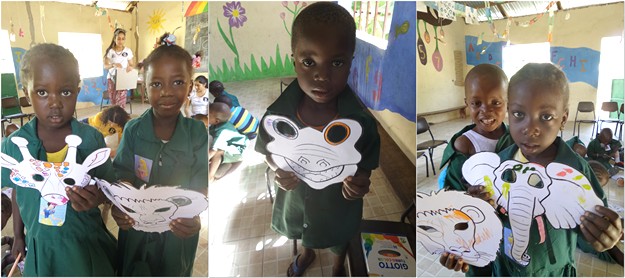
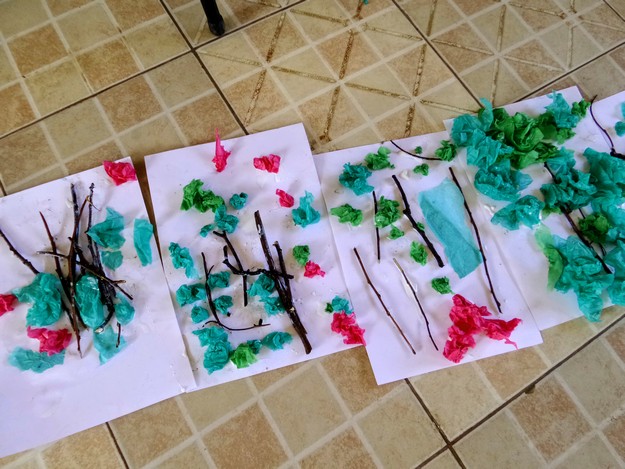
Next, we made trees by sticking twigs onto the page and using tissue paper for leaves. Although it was difficult to stop some children from eating glue and twigs and others from escaping from the class room, the hard work was worth it as the final art pieces were phenomenal.
Ruhaab and Sara- 4-5 year olds
As we walked in the classroom we were greeted by many smiley faced children. We started off with an icebreaker to learn everyone’s names by throwing around a beach ball. For the first activity we wanted to create an alphabet line to hang across the room. The children were each given a letters to decorate. When we hung the letters up we appreciated the hard work the children had put into decorating.
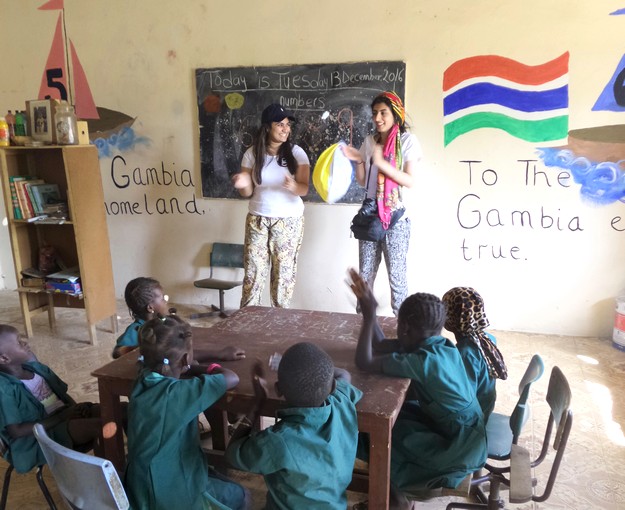
We wanted to appreciate the children’s beautifully individual names by making them each a personalised name bracelet. They loved the bracelets and by the end of the day were showing them proudly to everyone that passed by.
Sophie and AJ- 5- 6 year olds
We walked into a classroom of smiling and singing children all awaiting our activity. We started off with an ice breaker with cards of different topics such as: weather, numbers, letters, animals and sports where they would match the picture to the word that describes it. The children then chanted each word as a way of remembering it and using songs that they already knew to put words that they already knew into context, for example, they knew what a bird was due to it being in one of their favourite songs however when seeing a picture they were unaware of what it was.
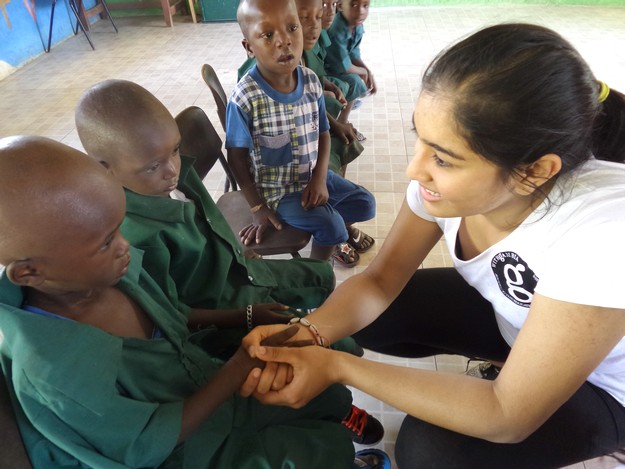
Our main activity was for each child to design a plain cap using foam stickers and coloured fabric pens allowing them to create a personalised piece of memorabilia from our activity that would be practical in their everyday life because of the Gambian heat. The children thoroughly enjoyed our activity showing their designs off proudly to us and their friends. The teachers also all created caps for themselves with colourful designs and their names clearly written on.
We then embarked on the last journey of the day which was a one-hour canoe ride from the North bank of the river back to the South bank. After wading through the muddy marshland we, not so gracefully, clambered onto the motorised canoe. Some snoozed in the sun while others looked out for crocodiles and birds. The open water and surrounding marshland is home to a large variety of birds including storks, pelicans and osprey, which the captain kindly pointed out to us. We arrived at the Tendaba Safari Camp at 3 pm where we relaxed for a few hours and watched the Gambian sun set over the river. After a delicious meal including barbequed fish, bush pig with the local peanut sauce we were taught some dance moves from the locals. We soon retired to our rooms exhausted from the day’s activities!
Wednesday 14th December
Day 5 – Sara B
We left Tendaba camp at 9:00 after breakfast travelling west along the south bank of the river. We passed through a few market towns and small farming communities waving a final goodbye to the village children and giving out pencils and sweets. After two and a half hours we arrived at the monkey park near our hotel. It was very cool under the canopy of the trees and we enjoyed feeding the monkeys nuts and watching them play. We finally headed back to our hotel for a well-earned rest and enjoyed an afternoon of water sports.
Thursday 15th December
Day 6 – by Sophie B
Our first activity involved travelling to Bakua, more specifically the pool at Katchikally. This is a sacred crocodile pool which is a natural pool discovered in the 1600s. It’s is a protected site which is surrounded by virgin forest. In Gambian culture, this pool is sacred and the water is supposed to have powers that can make infertile women fertile after bathing in the water. If a woman then gives birth to a child after visiting the sacred pool they have to use ‘Katchycally’ as the middle name of the child. As for the crocodiles, they laid around the pool soaking up the sun. These crocodiles are well fed by the workers at the pool and are very docile. We all had the opportunity to take pictures with the crocodiles and feel their surprisingly soft skin. The crocodiles grow to the environment therefore most of the crocodiles are small, around 1-1.5 metres, but the oldest crocodile Charlie is 60 years old and 2.5 metres long. Before this we visited the museum on the site. This included traditional drums and musical instruments that we all enjoyed trying to play. They also had a display showing the juju the traditional West Africans used to wear to protect themselves which we all found really fascinating.
We were warmly welcomed by Karamou and Sayku into the Batik workshop. They provided us with stretched cloth, pencils to plan, sticks with tips wound with copper wire and hot candle wax as the ingredients for a masterpiece. With inspiration from the environment and the previous days spent in Gambia we sketched out our plan onto the cloth and soon waxed over the pencil marks. This was then dipped into a vibrant yellow dye and strung up in the African sun to dry. Then we repeated the process to block out yellow and leave all the remaining cloth a purple. We were excited to see our personal art pieces the next day!
Friday 16th December
Day 7 – by Sara B
We took a visit to a bee farm organised by an African charity called BeeCause which not only looks after the bees but also has a training school to pass on their valuable methods. We were taught the biology and the history of the bees including harvesting time and the anatomy with role play.
In the evening we were greeted by all the children at Lamin’s compound and finally met the family both Lamin and Smiler had told us all about. Lamin’s wife, Mariama, prepared us a lovely meal to accompany our mini prize giving presentation followed by thanks and dance for our guides and their families to end the wonderful visit.
Latest News
Miss Marjorie Hulme
When we reflect on the history of our school and the people who have made it the place of outstandin…
Seven Students Celebrate Oxbridge Offers
Seven of Withington’s Year 13 cohort are celebrating offers to study at the Universities of Cambri…
Ruth Bayley Competition 2024
'Birds' is the theme of this year's Ruth Bayley Illustration Competition. Open to all pupils in the …

